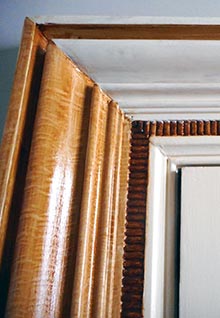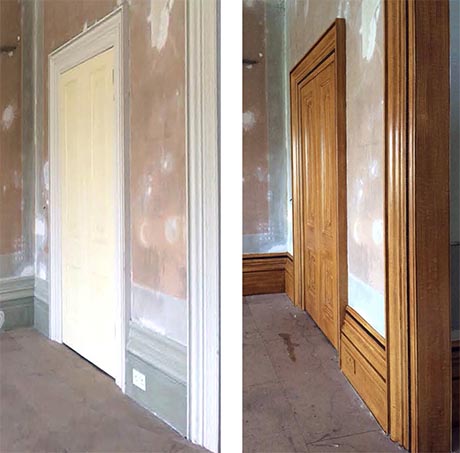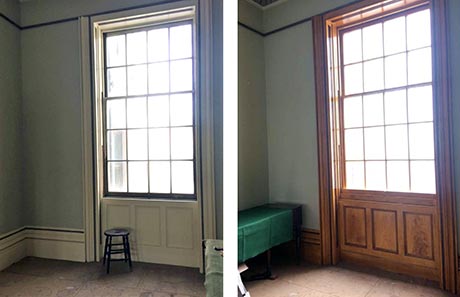Satinwood graining worthy of Regency times…
A beautiful change has occurred within the house over the last couple of years.

Slowly and steadily, an elegant finish to the woodwork has been developing throughout, calmly and quietly taking over to transform the intricate and ornate carvings, which for years have called out to be decorated and given the grand finish they so rightfully deserve.
Our curator Nick Tyson, has been waiting for the perfect painting team with the right combination of skills, making sure they were trained in the original techniques and finishes that would have been applied to the house when it was built in the 1820s.
Amidst the hive of activity that has more recently become The Regency Town House, the painters are a constant presence in the background. Sitting in cold corridors and working on high ladders, they are always there, quiet, methodical, tirelessly working to recreate the satinwood graining effect that was so fashionable in the Regency period.
As always, at the Town House, the team is made up entirely of volunteers and, as always, these volunteers bring their own unique backgrounds and skill sets to the restoration work. (The group includes those with backgrounds in heritage restoration and stage design.) Most of all, they bring their passion for the project.

Doors, architraves and skirtings; so much woodwork to grain.
Heading up this team is Karolina London, a professional restorer with a heritage and traditional skills qualification, who joined the Town House volunteers three years ago. “I had carried out wood graining work before but had not learnt satinwood graining so this was an exciting new skill to acquire. Jon Latham a Conservator of Painted and Decorated Surfaces from the Brighton Pavilion kindly came in to teach us the delicate technique,” and so the painstaking project of the woodwork decoration began. “The satinwood grain pattern consists largely of the moire effect and crisscross moire with a light veining. It is applied in two layers using Clear Acrylic Glaze mixed with Universal Acrylic Colourants”, Karolina explains, “and a variety of special brushes are used such as spalters, badger brushes and pencil grainers to achieve the graining effect with the final surface suggesting the shimmer of silk“.

The rear drawing room windows before and after graining.
The painting began with the large sash windows in the upstairs drawing room and, little by little, spread to the skirting boards, shutters, door frames, doors and down the main staircase, appearing room by room, weaving its way into the very being and soul of the house. After nearly 200 years, the satinwood is restored to how it would have looked when the house was first built.
The woodwork decoration has breathed new life into dark corners and reminded all who work here and visit, that this house used to be very grand indeed. It is becoming, true to Nick Tyson’s original vision, a real window to the past.
Please come and visit us at The Regency Town House on one of our open days and see the newly-restored woodwork.




Comments
Paul Couchman
Sun, 15/12/2019 - 15:48
Permalink
Love the photos
great article
Add new comment